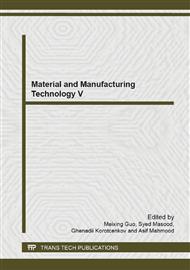[1]
J. Powel, CO2 Laser cutting, New York: Springer-Verlag, (1998).
Google Scholar
[2]
N. Jebbari, M.M. Jebari, F. Saadallah, A. Tarrats, R. Bennaceur, J.P. Longuemard, Themal affected zone obtained in machining steel XC42 by high-power CO2 laser, Optics and Laser Technology, vol. 40, p.864–873, (2008).
DOI: 10.1016/j.optlastec.2007.11.006
Google Scholar
[3]
I. Decker, J. Ruge, U. Atzert, Physical models and technological aspects of laser gas cutting, Proceeding of SPIE, Industrial applications of high power lasers, vol. 4, p.81–88, (1984).
DOI: 10.1117/12.966211
Google Scholar
[4]
D. Pantelis, Laser de puissance, traitement et utilization, " Techniques de l, ingénieur, vol. AF3, no A1095, (1992).
Google Scholar
[5]
N. Ben, C. Chen, L. Furong, Optimization on the fiber laser micro-cutting of thin stainless steel sheet by artificial neural networks, , Advanced Science Letters, vol. 4, p.810–813, (2001).
DOI: 10.1166/asl.2011.1452
Google Scholar
[6]
M. Radovanovic, P. Dasic, Rresearch on surface roughness by laser cut, , The Annals of University Dunarea de Jos of Galati Fasicule VII, Tribology, pp.84-88, (2006).
Google Scholar
[7]
I. Miraoui, E. Elimi, M. Boujelbene, E. Bayraktar, Analysis of roughness and microstructure for high-power laser cutting of stainless steel, Advanced Science Letters, vol. 19, pp.483-486, (2013).
DOI: 10.1166/asl.2013.4775
Google Scholar
[8]
C. Esposrro and G. Daureli, Tuning of a parametric model for the laser cutting of steels, Optics and Lasers in Engineering, vol. 2, pp.161-171, (1981).
DOI: 10.1016/0143-8166(81)90017-8
Google Scholar
[9]
H. Hocheng and C. T. Pan, Section area of heat affected zone in laser cutting of carbon fiber-reinforced PEEK, , Machining of advanced composites, vol. 66, (1993).
Google Scholar
[10]
I. Miraoui, M. Boujelbene and E. Bayraktar, Effects of laser cutting main parameters on microhardness and microstructure changes of stainless steel, , Advanced Materials Research, vol. 664, pp.811-816, (2013).
DOI: 10.4028/www.scientific.net/amr.664.811
Google Scholar
[11]
M. Zaied, I. Miraoui, M. Boujelbene, and E. Bayraktar, Analysis of heat affected zone obtained by CO2 laser cutting of low carbon steel (S235), , AIP Conference Proceedings, vol. 1569, pp.323-326, (2013).
DOI: 10.1063/1.4849285
Google Scholar
[12]
N. Rajaram, J. Sheikh-Ahmad and S.H. Cheraghi, CO2 laser cut quality of 4130 steel, International Journal of Machine Tools & Manufacture, vol. 43, pp.351-358, (2003).
DOI: 10.1016/s0890-6955(02)00270-5
Google Scholar
[13]
I. Miraoui, M. Zaied and M. Boujelbene, Effect of laser beam diameter on cut edge of steel plates obtained by laser machining, , Applied Mechanics and Materials, vol. 467, pp.227-232, (2014).
DOI: 10.4028/www.scientific.net/amm.467.227
Google Scholar
[14]
B.S. Yilbas, S.S. Akhtar, Laser cutting of Kevlar laminates and thermal stress formed at cutting sections, , Optics and Lasers in Engineering, vol. 50, pp.204-209, (2013).
DOI: 10.1016/j.optlaseng.2011.09.004
Google Scholar


